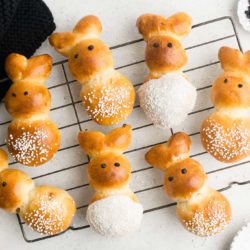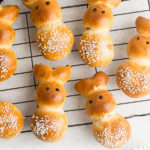Zopfhasen (Easter Bunny Rolls)

- Resting Time: 1 hour
- Prep Time: 1 hour
- Cook Time: 20 mins
- Total Time: 1 hour 20 minutes
- Yield: Makes 12 buns
- Category: Bread
- Method: Oven
- Cuisine: Swiss
Cute and delicious Zopfhasen, which are Swiss Easter Bunny Rolls, filled with raisins and decorated with pearl sugar. Easy recipe which you can make with the kids, with step-by-step photos.
Ingredients
For the dough
- 600 g (4 cups) strong white bread flour
- 110 g (1/2 cup) caster sugar
- 1 teaspoon fine salt
- 14 g (4 teaspoons) instant dried yeast (see Kitchen Notes below)
- 375 ml (1 1/2 cups) milk, warmed to 37°C (98°F)
- 60 g (4 tablespoons) butter, softened
- 40 g (1/4 cup) sultanas or raisins (or more, to taste)
For the face
- small handful dried currants, dried blueberries or raisins
For the egg wash
- 1 egg, lightly beaten
- 1 tablespoon milk
To decorate
Instructions
To make the dough
- Measure the flour, sugar, salt and yeast into the bowl of an electric stand mixer.
- Lightly mix the ingredients together using the dough hook.
- Slowly pour in the warm milk, and continue mixing until everything comes together into a rough dough.
- Add the butter, one tablespoon at a time. Once the butter has been fully incorporated into the dough, add the next tablespoon of butter.
- Once all of the butter has been added, continue kneading the dough on medium speed for about 15 to 20 minutes.
- The dough is ready when it is soft and smooth, and also slightly elastic in texture when you try to stretch it. If you poke the dough softly, it should bounce back right away.
- Lightly oil a large mixing bowl.
- Place the dough inside the bowl.
- Cover the dough with a clean tea towel.
- Leave the dough somewhere warm for 1 to 1.5 hours, or until the dough has doubled in size (see Kitchen Notes below).
- Once the dough has doubled in size, punch back the dough to release all of the air.
- Gently knead the dough a few times, and then knead in all of the raisins.
To portion the dough
- Pat the dough into a long log.
- Portion the dough.
- For each bunny, you will need 3 pieces weighing 20 g/0.7 oz (ears), 30 g/1 oz (head) and 50 g/1.8 oz (body). From this recipe, you should have enough dough for 12 bunnies, with a bit leftover. Weighing the pieces will help you to make nicely proportioned bunnies, but you can also simply guess the weight and improvise as you go.
- Roll each piece of small dough into a smooth ball and set aside.
To shape the dough
- Attach the heads to the bodies of each bunny by firmly pressing them together.
- For the ears, roll the dough into an oval shape. Use a sharp knife to cut an incision in the middle of the dough, but only 3/4 down the length of the dough, to form the ears.
- Loosely cover the bunnies with a sheet of cling film, and place them somewhere warm for about 20 minutes, or until they have puffed up slightly.
- Repeat with the remaining dough. I tend to prepare 6 bunnies at a time, or enough to cover one baking tray.
To bake the Zopfhasen or Easter Bunny Rolls
- Preheat the oven to 220°C/428°F (without fan).
- Make the egg wash by lightly whisking together the egg and milk.
- Brush the bunnies with some egg wash.
- Insert the eyes on the bunnies.
- Sprinkle pearl sugar generously over the body of the bunnies.
- Bake for about 15-20 minutes, or until the bunnies are lightly golden. Check the bunnies at about 10 minutes, and if they are browning too quickly, cover them with a loose sheet of foil for the rest of the baking time.
- The bunnies are cooked if an internal thermometer reads 85°C (185°F).
- Gently remove the bunnies to a wire rack, and leave them to cool completely.
Kitchen Notes
 ALTERNATIVES TO PEARL SUGAR
ALTERNATIVES TO PEARL SUGAR
If pearl sugar is not available, you could use sprinkles or mini chocolate chips.
 VARIATIONS
VARIATIONS
* Instead of raisins, use the same quantity of chocolate chips.
* If you want to try my Aussie version, make a simple icing by mixing together 1 cup of icing sugar (powdered sugar) with a dash of milk until you have a thick icing. Spread the icing over the bodies of the bunnies, and sprinkle with dessicated coconut.
 DIFFERENT TYPES OF FLOUR
DIFFERENT TYPES OF FLOUR
* For Swiss readers: I use Zopfmehl (or farine pour tresse) when making bread and enriched dough.
 DIFFERENT TYPES OF YEAST
DIFFERENT TYPES OF YEAST
* Please note that there is a difference between instant yeast (also called instant dried yeast or fast-action dried yeast) and dried yeast (also called active dry yeast). If you are not sure what type of yeast you have, please check the packaging for instructions on how to use the yeast.
* With instant yeast, you can add it directly to the flour mixture without having to activate it first.
* With dried yeast, you will need to activate it first (usually in some warm liquid).
* If you are using fresh yeast, you will need about one block (40 g fresh yeast = 14 g instant dried yeast). Crumble the fresh yeast into the warm milk, and stir to dissolve the yeast.
 PROOFING THE DOUGH
PROOFING THE DOUGH
Dough needs a warm environment for the yeast to activate and cause the dough to rise. If you don’t have a warm place in your home, try one of the following ideas:
* In the oven with the oven light switched on (works only for some ovens).
* In the oven with a tray of boiling water on the bottom shelf.
* In the oven at a low temperature of about 25-40°C (77-104°F).
 OVEN TEMPERATURES
OVEN TEMPERATURES
All recipes on this website state temperatures for a regular oven (i.e. a conventional oven without fan). If you have a fan-forced oven, reduce the temperature by about 20°C/35°F and possibly also the cooking time, but please consult your manufacturer’s instructions for best results.
 CONVERSIONS
CONVERSIONS
To convert from cups to grams, and vice-versa, please see this handy Conversion Chart for Basic Ingredients.
View the recipe online: https://eatlittlebird.com/zopfhasen-easter-bunny-rolls/


